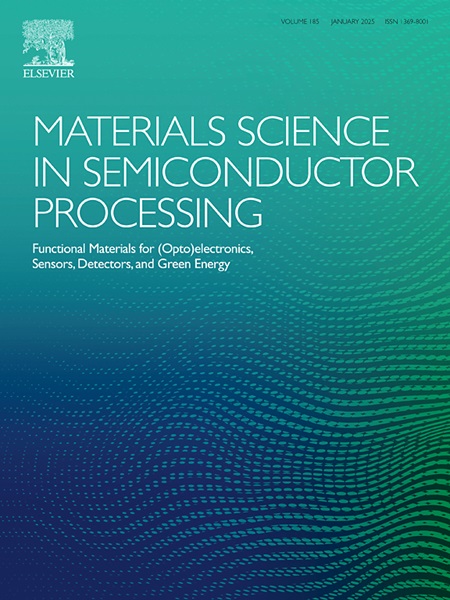Photoassisted decoration of Ag nanoparticles onto TiO2 nanorod arrays for continuously reusable ultrasensitive SERS sensors
IF 4.2
3区 工程技术
Q2 ENGINEERING, ELECTRICAL & ELECTRONIC
引用次数: 0
Abstract
Herein, a hybrid nanoarray-based surface-enhanced Raman scattering (SERS) sensor was developed to obtain dual functionalities of SERS signal amplification and photocatalytic reusability for detecting trace organic pollutants and antibiotic residues in environmental water. The plasmonic metal was created by controlling the formation of Ag nanoparticles (NPs), which were uniformly anchored within rutile TiO2 nanoarrays (r-TNRs) to form the Ag@r-TNRs platform. The SERS performance of the Ag@r-TNRs platform was obtained by optimizing photo-induced reduction strategy. Crystal violet (CV) and chloramphenicol (CAP) were chosen to assess the SERS behavior of the Ag@r-TNRs platform. The high sensitivity for detecting trace amounts of target molecules of Ag@r-TNRs hybrid nanostructure experienced both local electromagnetic mechanism (EM) and efficient charge transfer (CT). The prepared substrates exhibited ultralow detection (10−12 M for CV and 10−11 M for CAP) and high enhancement factors (EF) in the order of 4.9 × 109 and 5.6 × 108 for CV and CAP, respectively. Furthermore, duplex detection of dyes (CV and CAP) was successfully accomplished using Ag@r-TNRs to estimate SERS applications. Thanks to the excellent photocatalytic properties of TiO2, the layered structures possessed steady and effective ultraviolet (UV) cleaning performance. After UV irradiation for 40 min, 99 % of the CV were completely decomposed at a UV illumination. This SERS substrate can be reused for many times with a determined recovery rate of 93 %. Accordingly, the bifunctional Ag@r-TNRs substrate shows great potential for SERS analysis and photocatalytic performance in water environmental remediation.
在二氧化钛纳米棒阵列上光辅助装饰银纳米粒子,以制造可连续重复使用的超灵敏 SERS 传感器
本文开发了一种基于混合纳米阵列的表面增强拉曼散射(SERS)传感器,以获得 SERS 信号放大和光催化重复使用的双重功能,用于检测环境水体中的痕量有机污染物和抗生素残留。质子金属是通过控制银纳米粒子(NPs)的形成而产生的,它们被均匀地锚定在金红石型二氧化钛纳米阵列(r-TNRs)中,形成 Ag@r-TNRs 平台。通过优化光诱导还原策略,获得了 Ag@r-TNRs 平台的 SERS 性能。选择结晶紫(CV)和氯霉素(CAP)来评估 Ag@r-TNRs 平台的 SERS 性能。Ag@r-TNRs 混合纳米结构对痕量目标分子的高灵敏度检测同时经历了局部电磁机制(EM)和高效电荷转移(CT)。所制备的基底具有超低的检测量(CV 为 10-12 M,CAP 为 10-11 M)和较高的增强因子(EF),CV 和 CAP 的增强因子分别为 4.9 × 109 和 5.6 × 108。此外,利用 Ag@r-TNRs 成功实现了染料(CV 和 CAP)的双重检测,从而估计了 SERS 的应用。得益于 TiO2 卓越的光催化特性,层状结构具有稳定有效的紫外线(UV)清洁性能。紫外线照射 40 分钟后,99% 的 CV 在紫外线照射下完全分解。这种 SERS 基底可以多次重复使用,经测定回收率为 93%。因此,双功能 Ag@r-TNRs 基质在水环境修复的 SERS 分析和光催化性能方面显示出巨大的潜力。
本文章由计算机程序翻译,如有差异,请以英文原文为准。
求助全文
约1分钟内获得全文
求助全文
来源期刊

Materials Science in Semiconductor Processing
工程技术-材料科学:综合
CiteScore
8.00
自引率
4.90%
发文量
780
审稿时长
42 days
期刊介绍:
Materials Science in Semiconductor Processing provides a unique forum for the discussion of novel processing, applications and theoretical studies of functional materials and devices for (opto)electronics, sensors, detectors, biotechnology and green energy.
Each issue will aim to provide a snapshot of current insights, new achievements, breakthroughs and future trends in such diverse fields as microelectronics, energy conversion and storage, communications, biotechnology, (photo)catalysis, nano- and thin-film technology, hybrid and composite materials, chemical processing, vapor-phase deposition, device fabrication, and modelling, which are the backbone of advanced semiconductor processing and applications.
Coverage will include: advanced lithography for submicron devices; etching and related topics; ion implantation; damage evolution and related issues; plasma and thermal CVD; rapid thermal processing; advanced metallization and interconnect schemes; thin dielectric layers, oxidation; sol-gel processing; chemical bath and (electro)chemical deposition; compound semiconductor processing; new non-oxide materials and their applications; (macro)molecular and hybrid materials; molecular dynamics, ab-initio methods, Monte Carlo, etc.; new materials and processes for discrete and integrated circuits; magnetic materials and spintronics; heterostructures and quantum devices; engineering of the electrical and optical properties of semiconductors; crystal growth mechanisms; reliability, defect density, intrinsic impurities and defects.
 求助内容:
求助内容: 应助结果提醒方式:
应助结果提醒方式:


